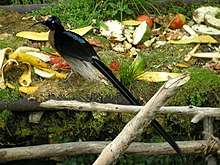Epimachus
Epimachus is a genus of bird-of-paradise from highland forests in New Guinea. These two species are surely one of the more bizarre members of the family.
| Epimachus | |
|---|---|
 | |
| Brown sicklebill, Epimachus meyeri | |
| Scientific classification | |
| Kingdom: | Animalia |
| Phylum: | Chordata |
| Class: | Aves |
| Order: | Passeriformes |
| Family: | Paradisaeidae |
| Genus: | Epimachus Cuvier, 1816 |
The common name "sicklebill" refers to their long, decurved, sickle-shaped bill. What makes the males of these birds eccentric are two aspects: firstly, their hyperbolically long, saber-like, black tails that reach around 18 inches alone; the other features are two marvelous pectoral fans on each side of the breast that the birds bring up over their heads during their displays. There are extensive iridescent areas of feathers found on the head and back of the males; additionally, blue gloss is present on the tail. The females of both species both have barred underparts, olive-brown upperparts and relatively long tails, though not as extensive as the males' tails.
The Epimachus birds are often referred to as "Long-tailed" Sicklebills when describing them collectively as a genus. The other sicklebills (genus Drepanornis) are referred to as the "Short-tailed" sicklebills. Ironically, the two genera are not closely related. The Epimachus members belong to a clade with the astrapias and paradigallas, while the Drepanornis species are closely related to the Twelve-wired bird-of-paradise, Standarwing bird-of-paradise, superb birds-of-paradise, and the riflebirds. There may also be confusion with the birds of the same name that belong to the hummingbird family, found in the Americas.
Species
| Image | Common Name | Scientific name | Distribution |
|---|---|---|---|
_-_Paradisaeidae_-_bird_skin_specimen.jpeg) | Black sicklebill | Epimachus fastosus | Found in the Vogelkop region, Wandammen peninsula, and central New Guinea at altitudes of 1500-2000 m. |
 | Brown sicklebill | Epimachus meyeri | Found across central New Guinea to the Bird's Tail region (Papuan Peninsula) to the southeast at altitudes from 2000 to 3000 m. |